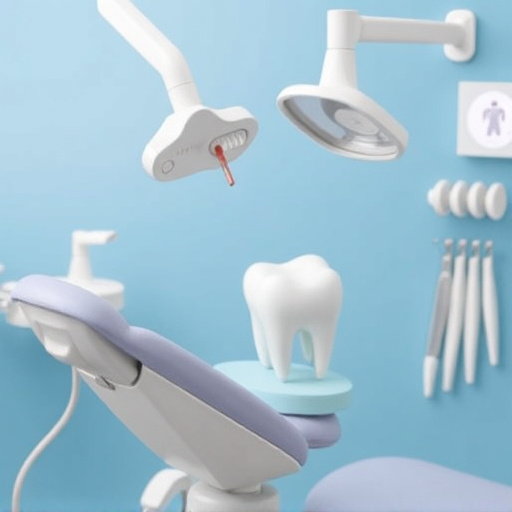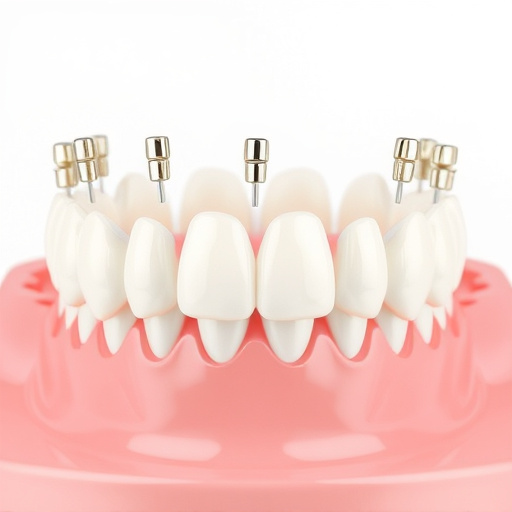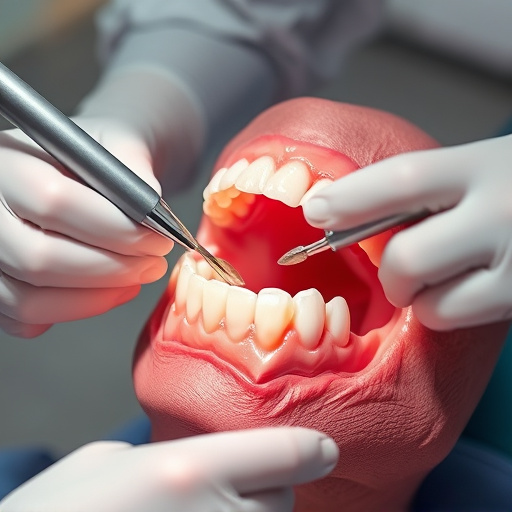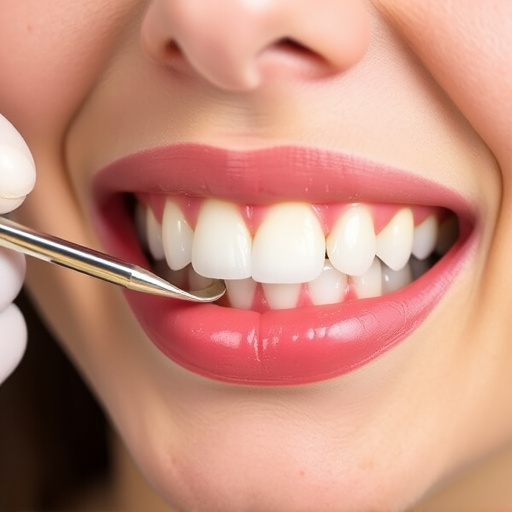Painless Tooth Extraction Services: Modern Techniques and Step-by-Step Guide
Tooth extraction services are crucial for managing damaged, infected, or impacted teeth. Modern dent…….
Tooth extraction services represent a critical component of dental care, offering a solution for various oral health issues when conservative treatments are insufficient. This article aims to delve into the intricate world of tooth extraction, exploring its historical foundations, global impact, economic implications, technological advancements, regulatory frameworks, and future prospects. By examining these aspects, we will provide readers with a comprehensive understanding of this essential dental procedure and its role in modern healthcare systems.
Definition: Tooth extraction, or tooth removal, is the process of surgically removing a tooth from its socket in the jawbone. This procedure is indicated when a tooth is severely damaged, infected, impacted, or causing discomfort or pain that cannot be alleviated through other means.
Core Components:
Assessment and Planning: Dental professionals begin with a thorough examination, including X-rays and 3D imaging, to determine the best approach for extraction. This step involves identifying the tooth’s position, surrounding structures, and potential complications.
Anesthesia Administration: Local anesthesia is typically used to numb the area around the affected tooth, ensuring patient comfort during the procedure. In some cases, conscious sedation or general anesthesia may be employed, especially for complex extractions.
Extraction Technique: The method varies based on the tooth’s position and condition:
Post-Extraction Care: After extraction, patients are given instructions for proper healing, including maintaining oral hygiene, managing pain, and adhering to dietary guidelines.
Historical Context: Tooth extraction has a long history, dating back to ancient civilizations. Early methods involved the use of crude instruments like stone or bone tools. The 19th century saw significant advancements with the introduction of anesthesia and improved surgical techniques. Today, modern dental practices employ advanced technologies and evidence-based protocols to ensure safer and more effective extractions.
Significance: Tooth extraction is not just a procedure but a decision-making process that considers the patient’s overall oral health, aesthetic goals, and long-term well-being. It plays a vital role in:
Preventing Complications: Removing infected or damaged teeth prevents the spread of infection and reduces the risk of systemic health issues.
Maintaining Oral Health: Extracted teeth create space that can be filled with implants or dentures, preserving the natural structure of the jaw and surrounding teeth.
Enhancing Quality of Life: By alleviating pain and discomfort, tooth extraction can significantly improve a patient’s overall quality of life.
Tooth extraction services are a global phenomenon, yet their accessibility and practices vary widely across different regions. Here’s an overview:
| Region | Access to Services | Prevalence of Extractions | Unique Considerations |
|---|---|---|---|
| North America | High access, with advanced dental care infrastructure | Relatively high, driven by cosmetic and orthodontic treatments | Focus on evidence-based practices and patient satisfaction |
| Europe | Varies by country; generally good access in urban areas | Moderate to high, influenced by national health policies | Emphasis on integrated oral health systems and preventive care |
| Asia | Varying access, with rapid improvements in dental care | Increasing, especially for cosmetic procedures | Cultural preferences and traditional practices impact demand |
| Latin America | Mixed access, with disparities between urban and rural areas | Generally lower but growing, linked to rising economic standards | Need for affordable dental services and community-based programs |
| Africa | Limited access in many regions; urban areas have better facilities | Lower compared to developed nations, affecting overall oral health | Challenges include inadequate infrastructure and healthcare funding |
Key Trends:
Growing Demand for Cosmetic Extractions: The rise of aesthetics-focused procedures, such as wisdom tooth removal for a more aligned smile, is driving demand globally.
Preventive Measures: Many countries are emphasizing preventive dentistry, aiming to reduce the need for extractions through regular check-ups and education.
Technological Integration: Advanced technologies like 3D imaging, laser-assisted procedures, and digital planning tools are improving precision and patient outcomes.
Teledentistry Growth: Remote consultations and virtual follow-ups enable access to dental care in underserved areas.
The economic landscape of tooth extraction services is multifaceted, impacting both patients and healthcare systems.
Market Dynamics:
Global Market Size: The global dental extraction market was valued at USD 7.2 billion in 2021 and is projected to grow at a CAGR of 5.8% from 2022 to 2030 (Grand View Research).
Regional Variations: North America dominates the market, followed by Europe, with Asia-Pacific exhibiting significant growth due to rising dental awareness and healthcare spending.
Investment Patterns: Dental practices invest in advanced equipment, training, and marketing to stay competitive. Private practices often charge based on procedure complexity, while insurance coverage varies across regions.
Impact on Economic Systems:
Job Creation: Tooth extraction services support numerous jobs, including dentists, dental hygienists, surgical specialists, and administrative staff.
Healthcare Spending: Dental extractions contribute to overall healthcare expenditure, with governments and private insurers allocating funds for these procedures.
Cost-Effectiveness: Preventive extractions can reduce long-term healthcare costs by avoiding more complex and expensive treatments.
Technological innovations have revolutionized tooth extraction services, enhancing safety, precision, and efficiency.
Key Advancements:
3D Imaging and Planning: Computerized tomography (CT) scans and cone-beam computed tomography (CBCT) provide detailed 3D visualizations, aiding in surgical planning and reducing complications.
Laser Technology: Dental lasers offer precise cutting and hemostasis, reducing the need for scalpel use and post-operative bleeding.
Digital X-rays: Digital radiography provides instant, high-resolution images, enabling dentists to detect subtle issues more easily.
Robotic Surgery: Robotic systems assist in complex extractions, offering enhanced control and accuracy, particularly for minimally invasive procedures.
Future Potential: The integration of artificial intelligence (AI) and machine learning (ML) algorithms holds promise for predictive analytics, personalized treatment planning, and improved surgical outcomes. Virtual reality (VR) and augmented reality (AR) could also transform patient education and consent processes.
Regulatory frameworks play a crucial role in ensuring the safety and quality of tooth extraction services.
Key Policies:
Licensing and Registration: Dental professionals must obtain licenses and registrations, adhering to educational and ethical standards set by dental boards.
Infection Control: Strict protocols for infection prevention, including sterilization procedures and personal protective equipment (PPE), are mandated in most jurisdictions.
Pricing and Insurance: Policies dictate reimbursement rates, insurance coverage, and patient responsibility for various extraction procedures.
Legislative Frameworks:
International Agreements: Organizations like the World Health Organization (WHO) promote oral health through guidelines and initiatives, influencing global standards of care.
National Regulations: Each country has its own dental practice acts and regulations, ensuring accountability and patient protection. For example:
Despite its advancements, tooth extraction services face several challenges and criticisms:
Inadequate Access: Disparities in access to dental care persist, particularly in underserved communities, leading to delayed or inadequate treatment.
High Costs: Extractions can be expensive, creating financial barriers for patients, especially those without insurance coverage.
Over-extraction: Critics argue that some extractions are unnecessary, driven by cosmetic trends or overzealous practices, potentially causing avoidable harm.
Infection Control Concerns: Despite strict protocols, rare cases of infectious diseases transmission through dental procedures raise concerns and require continuous improvement in infection control measures.
Strategies for Addressing Challenges:
Community Dental Health Programs: Governments and non-profit organizations can partner to provide mobile dental clinics and community outreach programs to improve access.
Insurance Coverage Expansion: Extending dental insurance benefits, especially for preventive services, can reduce financial barriers to care.
Continued Education: Dental professionals should engage in ongoing training to stay updated on best practices and avoid over-extraction.
Infection Control Audits: Regular audits of infection control protocols can ensure compliance and identify areas for improvement.
Setting: Rural India, where access to dental care is limited.
Initiative: A non-profit organization launched a mobile dental clinic equipped with advanced 3D imaging technology and specialized extraction equipment. The program focused on providing free or low-cost extractions for schoolchildren and underserved communities.
Outcomes:
Scenario: A private dental practice in a major metropolitan area introduced laser-assisted extraction techniques to reduce pain and healing time.
Implementations: Dentists received advanced training in laser dentistry and invested in specialized equipment. They offered these procedures alongside traditional methods, allowing patients to choose based on their preferences and budgets.
Results:
The future of tooth extraction services looks promising, with emerging trends and strategic considerations shaping its direction:
Growing Emphasis on Preventive Care: Dental professionals will continue to focus on education and preventive measures, aiming to reduce the need for extractions in the long term.
Integration of Teledentistry: Remote consultation and diagnosis technologies will expand access to extraction services, especially in rural or underserved areas.
Personalized Treatment: Advancements in AI and ML will enable tailored treatment plans based on individual patient needs and risk factors.
Minimally Invasive Techniques: Laser, robotic, and digital technologies will further evolve, offering safer, faster, and more comfortable extraction options.
Global Collaboration: International partnerships can lead to the sharing of best practices, research findings, and innovative solutions, improving global oral health standards.
Tooth extraction services are a critical component of modern dentistry, providing a solution to various dental issues while contributing significantly to overall oral health. This article has explored numerous aspects, from historical perspectives to technological innovations, regulatory frameworks, and global trends. By addressing challenges and highlighting successful initiatives, we have presented a comprehensive view of this essential dental procedure.
As the field continues to evolve, ongoing research, technological advancements, and strategic planning will shape the future of tooth extraction services, ensuring better oral health outcomes for millions worldwide.
Are tooth extractions painful?
Modern dental practices employ various techniques to minimize pain during extractions. Local anesthesia is commonly used, and advanced technologies like lasers can reduce post-operative discomfort.
How do I know if a tooth needs extraction?
A dentist will assess your oral health through examinations, X-rays, and 3D imaging. If a tooth is damaged beyond repair, impacted, or causing pain/infection, extraction may be recommended.
Is it better to keep a wisdom tooth or have it removed?
Wisdom teeth (third molars) can cause issues like impaction, infection, or damage to adjacent teeth. In many cases, removal prevents these complications and maintains oral health.
Can tooth extraction improve my smile?
Yes, extractions can be part of an overall cosmetic dental plan. Removing problematic teeth can contribute to a more aligned, aesthetically pleasing smile.
Are there any risks associated with tooth extraction?
Like any surgical procedure, extractions carry some risks, including infection, bleeding, and nerve damage. However, these are typically minimal when performed by qualified professionals adhering to strict infection control protocols.

Tooth extraction services are crucial for managing damaged, infected, or impacted teeth. Modern dent…….

Emergency tooth extraction services are vital for severe dental issues like damaged or infected teet…….

Tooth extraction services are vital for managing severe tooth decay or impacted wisdom teeth, preven…….

Tooth extraction services are crucial for maintaining oral health and achieving aesthetic goals, pre…….

Tooth extraction services, especially emergency extractions, address severe dental pain or potential…….

Tooth extraction services are necessary when teeth are severely damaged or causing pain. The process…….

Tooth extraction services are readily available and more affordable than ever, thanks to advanced de…….

Tooth extraction services are recommended for severely damaged or diseased teeth, with sedation opti…….